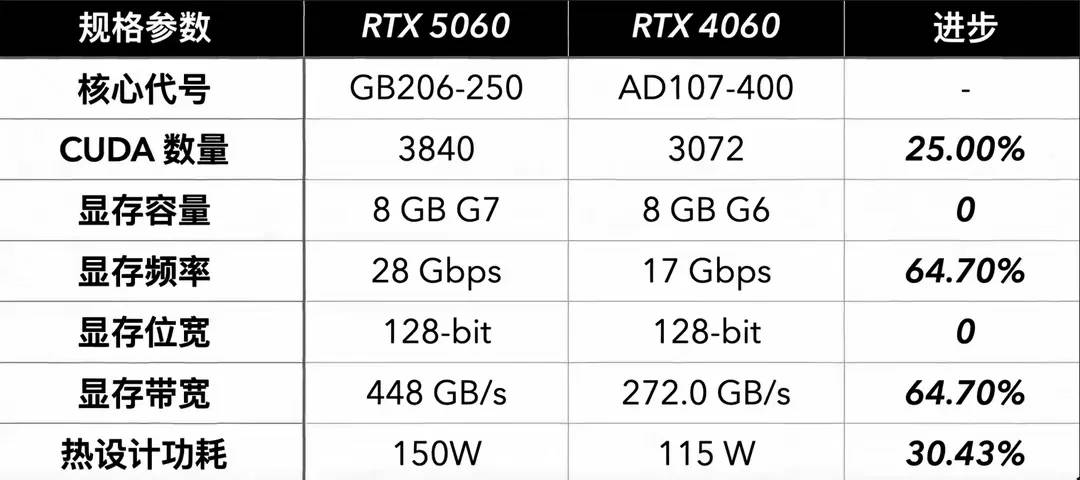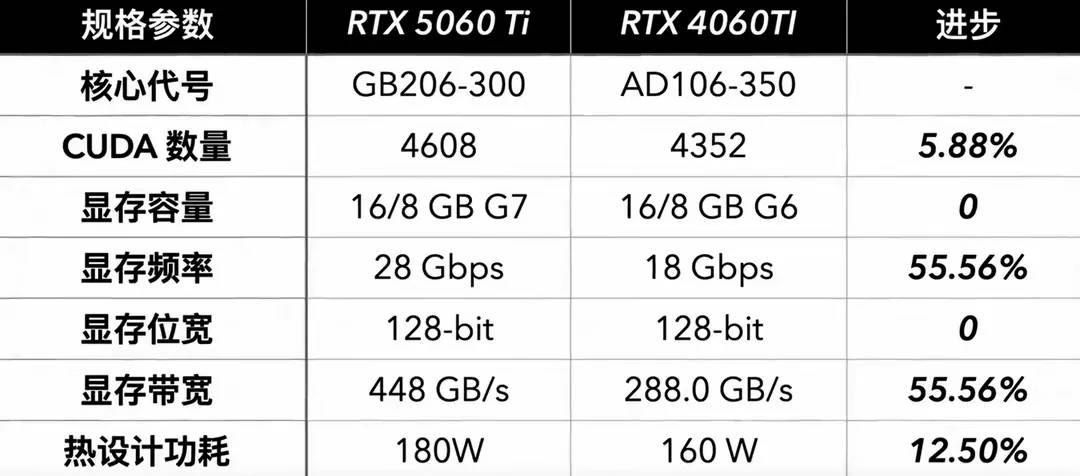RTX 5060 Ti vs. RTX 4060 Ti:
The VRAM gets a major upgrade from GDDR6 to blazing-fast GDDR7, with clock speeds skyrocketing from 18 Gbps on the 4060 Ti to an impressive 28 Gbps.
Nvidia remains stubborn though—the bus width stays locked at 128-bit (they just won’t let go of that 128-bit design).

Memory bandwidth makes a massive leap from 288 GB/s to a whopping 448 GB/s.
CUDA cores see a healthy bump from 4,352 to 4,608, though this comes with increased power demands—TDP jumps from 160W to 180W, a 20W hike over its predecessor.
*These memory and core upgrades deliver tangible performance gains, especially considering the higher power consumption—expect a noticeable boost even on the same process node.

*
RTX 5060 vs. RTX 4060:
Another GDDR6 to GDDR7 VRAM upgrade, with frequencies surging from 17 Gbps to 28 Gbps—that’s a massive 64% speed increase!
Once again, Nvidia plays it safe with the same 128-bit bus width (they’re clearly committed to this configuration).
Memory bandwidth sees an impressive climb from 272 GB/s all the way up to 448 GB/s.
The CUDA core count gets a nearly 25% boost, jumping from 3,840 to 3,072, though power requirements rise significantly—TDP increases from 115W to 150W, a 35W jump.
*Nvidia has clearly pushed the 5060 series harder this time. While leaks indicate we’re still stuck with 8GB VRAM (no 16GB variant), the performance leap is substantial—coming remarkably close to 4060 Ti territory.
*
The jump in memory bandwidth is impressive, but keeping the bus width at 128-bit feels like a missed opportunity, especially with the price tag. It’ll be interesting to see how this decision impacts performance in real-world applications versus the 4060 Ti.
Absolutely, the memory bandwidth increase is great, and you’re right that keeping the bus width at 128-bit is surprising given the price. I think NVIDIA might be targeting specific workloads where raw bandwidth isn’t as critical, but it will indeed be intriguing to see how this affects real-world performance compared to the 4060 Ti. Thanks for bringing up such an insightful point!
The jump in VRAM and memory bandwidth sounds great, but keeping the 128-bit bus feels like a weird choice—especially when prices are still so high. It definitely raises questions about whether NVIDIA is prioritizing innovation or just maintaining profit margins. I wonder how much of this is driven by hardware limitations versus strategic pricing decisions. Either way, gamers are going to feel the pinch.
Thanks for your insightful comment! You’re right that the 128-bit bus might seem unusual given the VRAM bump, and it does raise interesting questions about NVIDIA’s priorities. While I don’t have insider info, it could be a mix of both hardware constraints and strategic pricing. Either way, balancing innovation with affordability is always a delicate challenge for the industry. Cheers to thoughtful discussions!
The jump in memory bandwidth is impressive, but keeping the bus width at 128-bit feels like a missed opportunity. It’ll be interesting to see how this pricing strategy plays out, especially since the performance gains don’t seem to justify such a big leap in cost for some gamers.
The jump in memory bandwidth is impressive, but I can see why people are questioning NVIDIA’s pricing strategy. Keeping the bus width at 128-bit feels like a step backward when they’ve made such significant improvements elsewhere.
It’s interesting how the GDDR7 upgrade really seems to make a difference despite the same 128-bit bus width. I wonder if this performance boost justifies the price tag, especially given the ongoing debate about Huang’s pricing strategy. The memory bandwidth increase is impressive, but it feels like NVIDIA could have pushed even further with more core enhancements. Overall, it’s a solid update, but not groundbreaking for the price.
You raise an excellent point! While the GDDR7 memory does deliver noticeable improvements, the price is definitely a topic of discussion. I agree that core enhancements could have been more aggressive, but NVIDIA likely aimed for a balance between innovation and market demand. Thanks for sharing your insights—it’s always great to hear diverse perspectives on tech developments!